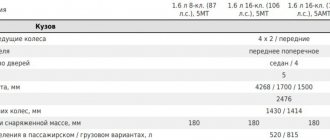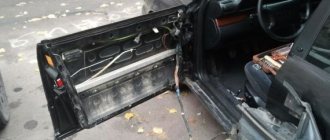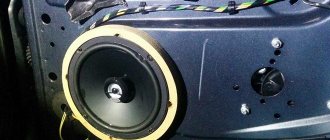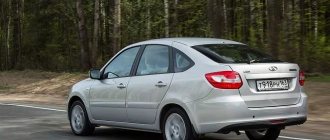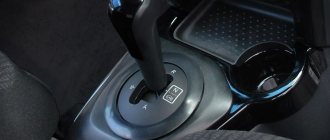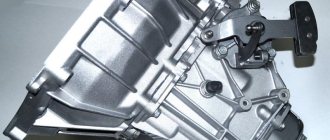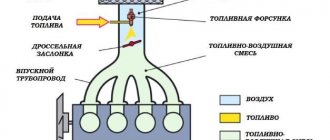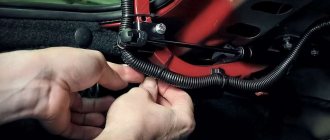Design and operating principle of AMT
In general terms, AMT is a conventional manual transmission in which two special actuators (servo drives) are responsible for clutch operation and gear shifting. Each actuator installed on the gearbox is an electric motor with a gearbox and an actuator. The entire system is controlled by an electronic unit that selects and engages the required gear.
New LADA Granta on robot
The electronic unit takes into account the vehicle speed and engine operating mode, as well as information received from systems that monitor traffic safety (ABS, BAS, EBD, etc.). Evaluating and analyzing all the information received, the electronics unit issues a command to change gear.
After receiving the corresponding signal, the clutch is depressed using one servo drive, and the second one at this time engages the desired gear. Then the first servo smoothly releases the clutch.
When operating in Tiptronic mode (manual control), the driver independently moves the selector knob towards higher or lower gear and thereby issues the AMT command.
Note: when using a robot, there is no need for a clutch pedal.
Main problems of DSG7 - video
Weak points of mechatronics
The weakest points are the mechatronics and clutch.
DSG 7 - disadvantages
There are car enthusiasts who are not 100% satisfied with the performance of this transmission. What could they not like and what problems arise in the DSG ?
Is the DSG7 gearbox that good?
— The appearance of jerks and vibrations in the DSG when changing gears. This drawback is caused by the fact that DSG clutch begins to wear out. The result is the same effect if you do not depress the clutch pedal when changing gear in a car with a manual transmission. In a word, the vibration spreads throughout the entire body, depending on the state of the clutch, and progresses until the gearbox completely fails.
— Extraneous noises under the hood. Mainly metal parts when driving over speed bumps.
— Reduced traction when accelerating the car. This problem is known to the developers and they promise to fix it soon.
AMT for LADA Granta. Design Features
Cars of the LADA Granta family (sedan, liftback) have already received a proven AMT, which is installed starting in September 2014. It was developed by engineers of JSC AVTOVAZ together with specialists from the German concern ZF Friedrichshafen AG, which is the author and owner of many modern technologies and innovative solutions in the field of drive systems.
The design of the basic manual gearbox 2181 (modernization of gearbox 2180) was taken as a basis, on which the following were installed:
- 1. Electromechanical actuators that control gear shifting and clutch operation;
- 2. Input shaft speed sensor;
- 3. Controller.
2180 gearbox and electronic control unit
In addition, the following were completely removed from the gearbox:
- 1. Clutch drive;
- 2. Internal switching mechanism;
- 3. Cable gear shift drive.
Inside the car, the clutch pedal was removed, and instead of a mechanical (cable) gear shift drive, an electronically controlled selector was installed.
In addition to original design solutions, modern software was developed specifically for AMT, with the help of which the vehicle’s transmission is controlled.
All these changes, together with the electronic motor control controller and the on-board power supply network, made it possible to fully automate the processes of controlling the clutch and gear shifting, as well as ensuring high AMT functionality.
What cars can it be installed on?
The first car under the Lada Priora brand, equipped with AMT, was released in 2014; the installed gearbox was modified AMT-2182. After running in and finalizing the mechanisms and program elements, automatic manual transmissions began to be equipped with the Lada Granta, this happened in March 2015, and the Lada Vesta, in 2016. The Lada Kalina and Lada Xray cars were equipped with the same gearbox.
Later modifications of the gearboxes are structurally similar to the first gearbox released by the company. The difference lies in the improved program of the latest version, which was developed by the German company ZF Friedrichshafen AG. The principle is based on the use of a new transmission switching algorithm and improved functional logic. AMT has a number of operational features and is characterized as a simple, reliable, economical unit.
Advantages and disadvantages of AMT
Among the many advantages of the “robot” are:
- 1. Cost-effective;
Fuel consumption in a car with an installed robot depends on driving style and is 6...6.5 l/100 km in mixed mode, which allows saving up to 30% of fuel compared to a sedan or liftback LADA Granta AUTOMAT and up to 10% compared to cars , equipped with conventional “mechanics”.
- 2. High reliability;
AMT is based on a manual gearbox, which is much less susceptible to breakdowns than an automatic transmission. In addition, the optimal operating modes of the robot are determined electronically (there is no “human factor”), which significantly increases the service life of the engine. Repairing an AMT is practically no different from repairing a manual transmission. In addition, it is much simpler and cheaper than automatic transmission.
- 3. Simplicity of design and unpretentious operation.
Electromechanical structural elements do not require maintenance or adjustment during operation. All connectors and electronic components are reliably protected from dust and dirt. The robot is adapted to difficult operating conditions and ensures operation when exposed to temperatures ranging from -40...+50 degrees Celsius.
- 4. Vibration comfort.
There is no mechanical connection between the selector and the gearbox, so there is no vibration of the mode shift handle.
LADA Granta on a robot
Existing disadvantages of AMT:
- When starting to move, LADA Granta with AMT may roll back a little.
- Unlike an automatic transmission, the robot cannot change gears without losing traction torque. This results in barely noticeable jerks during gear changes.
DSG 7 reviews
Car enthusiasts who switched from a car with a manual transmission to a DSG note that there are no problems using the transmission. The ability to manually change gears allows them to quickly adapt to the new gearbox. Drivers especially emphasize the efficiency of this gearbox. about the DSG are most often positive. Almost all negative reviews are related to the high cost of spare parts for the gearbox and the impossibility of overhauling the DSG. But there are some nuances that lead to the box breaking. Negative factors such as traffic jams, slippage, sudden starts from traffic lights contribute to rapid wear of the clutch and mechatronics.
Real reviews from DSG 7 owners | Video
We went through well-known forums and car clubs, but we won’t be able to parrot you with good reviews about the performance of the DSG 7. Unfortunately, this unit, according to the owners, is damp. Moreover, many (including the editor of this article) had mechatronics or clutch kits changed at low mileage, but this did not exclude further problems. The prospect of ending up with 80-150 thousand rubles worth of repairs is not encouraging.
AMT management
During operation, the “robot” is much simpler than automatic transmission and classic “mechanics”. The electronic selector allows you to use 4 operating modes:
- neutral - N;
- automatic - A;
- reverse - R;
- manual control - M.
Before you start driving, you need to set the selector lever to position “A”, then press the brake pedal and only then put your foot on the gas pedal.
Attention! The engine of a LADA Granta (sedan, liftback) equipped with a “robot” will not start if you forget to press the brake pedal.
The car's acceleration time to a speed of 100 km/h is 12.5 seconds, which is 1.6 seconds inferior to models with a manual transmission (10.9 seconds), but 0.8 seconds better than the LADA Granta with automatic transmission (13. 3 sec.). In this case, gear shifting occurs at 5000 rpm for aggressive driving or 2500 rpm for quiet driving.
The time to switch from one gear to another in automatic mode is no more than 2 seconds. Because of this, AMT may seem “thoughtful” to some drivers, but when switching to manual control mode, the gear shift speed is comparable to the speed of a manual transmission.
Device
Disc parameters, markings
It consists of several main components:
- Manual transmission with clutch (dry or wet)
- Control and switching drives. Can be electric, hydraulic
- Electronic unit (brain). The robot's operating characteristics depend on its settings and software.
Clutch
A dual-clutch transmission such as a DSG can be used to deliver full power and driver comfort. But all AMT gearboxes are based on a manual transmission.
For example: BMW uses a 6-speed manual transmission with an electro-hydraulic type.
Control drives
As mentioned above, there are two types of clutch actuators: electric and hydraulic. The first type uses electric motors, the second type uses hydromechanical pistons and cylinders with valves.
AMT robotic boxes with electric drives differ from their counterparts in their low switching speed: 0.3-0.5 seconds. In this case, less energy is spent. In hydraulic drives, the opposite is true - high gear shift speeds, high energy consumption, and therefore higher fuel consumption.
Different types of cars use different types of controls. It all depends on what the engineers want from the car. Economy and low cost of the car - robot with electric drive, switching speed - hydraulics.
The “brains” of a robotic automatic transmission
The electronic control unit consists of:
- sensors,
- The block itself
- Control transfer bodies.
The sensors share information with the electronics about the speed of rotation of the crankshaft and drive axles, the temperature of the oil in the hydraulic drive, and the position of the gearbox selector handle. The electronics processes signals and transmits control commands to the electric drive, hydraulic valves, interacts with the engine, anti-lock braking system (ABS), ESP and other vehicle systems.
Disadvantages of the gearbox
Even with such a list of advantages, the device also has its disadvantages, which may scare off some drivers. Let's look at them.
- Unfortunately, the most commonplace and cheapest robotic boxes are not able to adapt to the particular driving behavior of a particular driver. In this it was surpassed by the automatic transmission, which easily adapts to the driving style. There is only one type of driving here. It is built into the firmware as standard.
- If the robot box (reviews in this regard are quite negative) is installed in conjunction with an electric servo drive, then it shows a slight delay in operation. That is, the resulting pause between signal transmission and the switching itself sometimes reaches two seconds. This is not a serious drawback, but it can cause inconvenience when driving evenly and accelerating.
- If a hydraulic drive is used together with a robotic gearbox, then it should be noted that the switching speeds up to almost 0.05 seconds. This seems like a small number, but you can feel it while driving. But such a drive is both expensive to buy and expensive to install. Moreover, it heavily loads the engine in terms of energy, which is why it is often used in sports cars or other expensive cars.
General information about the AMT robot
- The mechanical part is based on a five-speed modification of the VAZ model 2180 gearbox. Moreover, this gearbox is equipped with gear pairs with different output ratios for different Lada models. For example, the Vesta box has this output indicator of 3.9, when, as on Grants and Kalinas, it is 3.7.
- You cannot take an actuator (clutch pressing mechanism) and robot electronics and put it on a regular box of the same VAZ 2180 model so that the result is a robot. Although the reverse procedure of replacing a robot with a mechanical one can be carried out with overcoming some obstacles.
- It is believed that the actuator cannot be repaired or maintained, but this is not for our craftsmen. Cases of its failure, judging by the reviews, are very rare. Usually, they happened at the beginning of operation, while still under warranty. There were no cases of refusal to replace.
- The recommendation to change the oil in the AMT at a mileage of 120 thousand does not stand up to the criticism of mechanics; they recommend doing this at 75 thousand mileage.
- The adaptability or adaptability of the transmission to changing operating conditions of the engine and its load, the position of the gearbox engaged mode sensors (ECP), as well as the gas and brake pedals is ensured by reading the sensor information and analyzing this information. And based on the algorithms embedded in the robot’s program, a certain order of its actions is formed. In this case, the driver’s actions in various situations are taken into account, which are stored in the robot’s long-term memory. If we say all this in a simple and understandable language for everyone, then the AMT transmission adapts to the characteristics of the driving style of a particular driver and road conditions. Moreover, for this she usually needs a couple of tens of kilometers of driving in the city.
- The AMT robot is sensitive to engine load and quickly responds to the activation of maximum torque. At the same time, each subsequent gear can be engaged only when the engine speed drops below 2.5 thousand, and each subsequent one when the range from 4 to 4.5 thousand revolutions is reached. In addition, the degree of load perceived by the engine is taken into account. For example, on a slope, the AMT robot will switch to a lower gear if the load on the engine decreases, but will leave it in the most economical operating mode.
- AMT has its own peculiarities of operation in accordance with the established transmission modes. For example, in “M” mode, the gearbox switches faster compared to “A” mode.
Development of the gearbox - the emergence of preselective
Due to the fact that the box has its shortcomings, the first developments were received rather poorly. The main thing that drivers did not like was the jerks that appeared when driving. Most likely, this was felt due to the low speed of operation. But the developers, due to the low cost and ease of assembly, continued to look for solutions to the problems that arose.
In order to correct the situation and reduce the delay time when switching, designers began to use boxes together with two clutches that operate independently of each other. This made it possible to completely get rid of significant delays and jerks. The dynamics of the car have increased significantly; Also, consumer demand has increased sharply. Even then, the robot box began to gain popularity. Owner reviews gradually became better.
Now let's talk about who was the first to use robotic gearboxes. The pioneers are Audi and the German Volkswagen. They have been installing such transmissions on their cars since 2003. Reviews about exactly how the gearbox works on their cars will be described below.
What were the benefits of using a double clutch? Due to it, the required gear is switched on before the previous one is switched off. And thus the car continuously moves from one to another, while maintaining traction in the required volume. This robotic gearbox is called preselective. She is the second generation. Returning to the design of the device, it must be said that a regular box of any type works with one primary and secondary shaft. The same design received two of them. For what? Each pair is responsible for either odd or even transmission. The primary shafts are arranged like a nesting doll, that is, one is nested inside the other. They are connected to the power unit via a multi-disc clutch.
Types of automatic transmission
Tire markings
The permanent race for technical equipment of cars forces developers to come up with more and more sophisticated technologies and designs in order to overtake competitors. It is worth noting that this has a positive effect on the development of the vehicle chassis. One of the most important discoveries was the invention of the automatic transmission. It immediately began to be in incredibly high demand, as it significantly simplifies the management process. In addition, it is very easy to use and reliable. Analysts claim that in the near future it will completely displace manual transmissions from the market.
Today, automatic transmissions are used in both cars and trucks, regardless of the type of drive.
It is known that when driving a car with a manual transmission, you have to constantly keep your hand on the gear shift, which significantly reduces concentration on the road. The automatic transmission is practically devoid of such shortcomings.
The main advantages of the automatic transmission:
- Management efficiency increases;
- Smoother transition between gears even at high speeds;
- The engine is not overloaded;
- Gears can be changed either manually or automatically;
Modern automatic transmissions, from the point of view of the monitoring and control system, can be divided into two types:
- Transmission with hydraulic device;
- Transmission with an electronic device, or the so-called robotic gearbox;
This should become clearer after reading the example below:
“Imagine a situation where a car is moving on a flat road and gradually approaches a steep hill. If you simply observe this situation from the side for some time, you will notice that after increasing the load, the machine begins to lose speed, and, consequently, the intensity of rotation of the turbine also decreases. This leads to the fact that the working fluid begins to resist movement. In this case, the circulation rate increases sharply, which helps to increase the CM to the point at which equilibrium occurs in the system.”
The same operating principle applies when the car starts moving. The only difference is that in this case the accelerator is also used. Thanks to it, the intensity of the crankshaft and pump wheel revolutions increases, while the turbine remains stationary, which allows the engine to idle. It is worth noting that the KM increases sharply, and upon reaching a certain point, the torque converter begins to serve as a link that connects the driven and driving elements together. It is all these points that allow you to significantly reduce the level of fuel consumption while driving, and more effectively perform engine braking if necessary.
So why then connect the automatic transmission to the torque converter if it is independently capable of changing the intensity of the torque converter?
Here's why: the torque change factor using a torque converter usually does not exceed 2-3.5. This is not enough for the automatic transmission to work properly.
Unlike a manual transmission, an automatic transmission changes gears using friction clutches and band brakes. The system automatically determines the desired speed taking into account the speed of movement and the force on the accelerator pedal.
In addition to the planetary mechanism and torque converter, the automatic transmission also includes a pump that lubricates the box. The oil is cooled by a cooling radiator.
